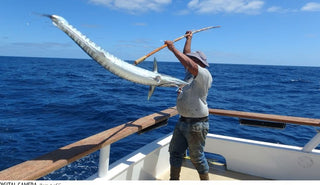Every angler wants bragging rights for the day's biggest catch. But even with the right location and technique, the size of your lure can make or break your success on the water. Knowing how different fish perceive and react to bait can give you an edge. Adjusting lure size to match the environment often leads to more bites. Even subtle differences can turn a near-miss into a landed trophy.
Why Lure Size Isn't Just a Number
In big game fishing, size isn't just a detail; it's a tactical component. If your bait is too small, the fish could ignore it, but if it's too large, it will scare off even the most aggressive of predators. For example, mahi lures have been manufactured in an assortment of sizes in order to suit the scale of the mouth opening and feeding behavioral patterns of mahi schools.
If your bait is the right size, it better emulates the prey the fish are already feeding on, which makes getting bites more probable.
Size also impacts movement, visibility, and the way your bait behaves in the current. A bait that is the right size for the environment can elicit attention without an unnatural look.
Reading the Fish: How Size Affects Strikes
Different species respond differently to lure size, and reading the water is key. Predatory fish gauge prey based on what's easiest to attack and consume. Juvenile fish often go for smaller prey, while larger predators might ignore anything under a certain threshold. Understanding these tendencies is why seasoned anglers often carry multiple lure sizes in their tackle boxes.
Observing surface activity can clue you in: when baitfish swarm, a medium-sized lure might be enough. If fish are picky, a bigger, more enticing target can trigger aggressive strikes. Pairing your lure size with observed behavior is what separates casual anglers from those consistently landing big catches.
Choosing the Right Lures for Offshore Success
Tuna are fast, intelligent, and selective predators. Choosing the right Tuna Lures can mean the difference between hours of missed opportunities and a rod bent double. Size plays a huge role- too small, and they sniff it and swim off. Too large, and the lure appears unnatural.
Seasoned tuna fishermen typically rotate through several sizes, depending on water clarity, what baitfish are available, and how hungry the fish are feeling that day. A larger lure will imitate a larger prey, but making accurate casts and recovering the lure can be demanding work. So, balance is key to success. The correct size lure in conjunction with suitable actions: twitchy, steady, or diving, will also markedly increase the chances of a strike.
Poppers and Surface Action: Getting it Right
Topwater fishing adds another layer of nuance. Tuna Poppers are designed to attract attention visually and audibly. Their surface splashes, pops, and wakes simulate struggling prey. But size still dictates effectiveness. A popper too small may vanish under sunlight and waves, while an oversized one might scare fish instead of enticing them.
Consider the rhythm of your strikes and how the fish react. Matching the size of your popper to the scale of the fish feeding around you ensures maximum engagement. Experienced anglers know it's not just about having a popper- it's about having the right popper size for the conditions at that moment.
Size and Technique: Beyond the Lure
Lure size is not just a factor working alone. Casting technique, retrieval speed, and water conditions interact with the lure's dimensions. Heavier lures travel farther but require stronger retrieval. Lighter ones might flutter more naturally, attracting smaller predators but risking wind or current interference.
The right size ensures that your lure behaves predictably and responds well to your technique. Anglers often find that adjusting lure size slightly can dramatically improve hook-ups, even in areas where bites were previously slow. It's subtle but powerful- the kind of insight that comes with experience on the water.
Expert Tips for Selecting Lure Size Every Time
- Carry a range of sizes to adapt to conditions.
- Observe local baitfish and adjust lure size to match prey.
- Test different sizes at the same location to see which triggers strikes.
- Consider depth, current, and water clarity- a lure that's too big or too small may lose visibility.
To assist you in selecting the ideal size for your next trip, contact us at Magbaylures today and talk with professional anglers who understand what works.
Choosing the correct lure size requires a blend of observation, research, and trial-and-error!
Offshore fishing is as much about precision as it is about patience. Lure sizes may seem minor at first blush, but they are often the reason that some have bragging stories while others go blank in their logbooks. If you have the right selection, watching the water and letting your lures speak for themselves will often tell you everything you need to know.

